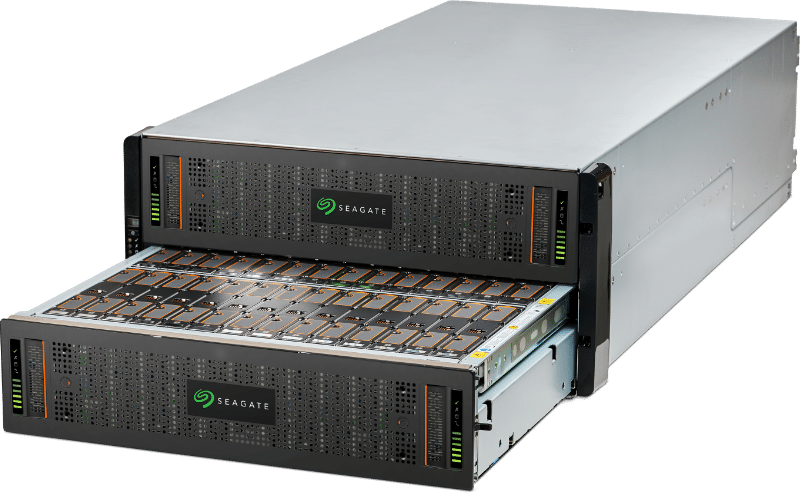Menu
Seagate EXOS X is an enterprise class storage array that can scale and deliver the capacity, performance and features. It easily supports additional storage trays supporting a mixture of SSD and hard disks to deliver massive storage capacity for future applications. Its fully redundant design has dual controllers, power supplies fans and hot swap drives. In addition, it has multiple 25Gb/s ports to deliver more than enough connectivity to satisfy future requirements.

Seagate ADAPT provides all the following features and enhancements to Linear volumes.
Larger Storage Pools: ADAPT can support significantly larger storage pools compared to traditional RAID configurations.
Faster Rebuilds: ADAPT is designed for rapid rebuilding after a drive failure, minimising downtime, up to 95% faster!
Data Protection Flexibility: ADAPT offers more flexibility in terms of data protection, allowing for a wider range of drive configurations and fault tolerance options.
Simplified Expansion: ADAPT allows for easier expansion of storage capacity by adding multiple drives at a time.
Unique two-device fault tolerance: Increased data protection, even in the event more than one device fails
ADAPT functions like RAID in that it is a data protection scheme, but its genius lies in dispersing the parity out to a number of drives. This structure enables the Seagate RAID controllers to take advantage of the combined performance of all those drives—versus being tied to a single drive. All drives in the ADAPT disk group must be the same type, and in the same tier, but can have different capacities. Consequently, ADAPT simplifies data centre management, allows for easy growth, ensures that end-user applications have access to critical data, and dramatically reduces the time to successful fault tolerance (the ability to properly withstand an additional impact). Thanks to ADAPT, the rebuild that took days now takes only minutes:
ADAPT offers several advantages over RAID 6, including:
When new data or new disks are added, or the system recognises that data is not distributed across disks in a balanced way, it will move the data to maintain balance across the disk group. Because disk space that is dedicated to sparing is spread across all disks in the system, spare capacity for ADAPT disk groups is automatically reserved. In the case of a disk failure, data will be moved to many disks in the disk group, allowing for quick rebuilds and minimal disruption to input/ output (I/O).
Linear Storage (e.g., RAID 0, RAID 5, RAID 6): Maximum number of drives supported limited to 16.
Directly Stored Data: Linear storage stores data directly across the drives, using a more traditional RAID approach.
Limited Storage Pools: Linear storage typically has limitations on the maximum number of drives that can be used in a storage pool.
Volumes: Unlike ADAPT, Linear uses the traditional approach to building RAID systems and as such isn’t as efficient at providing storage. For example, if we create 5x RAID 6 volumes of 12 drives, we will lose an additional 10 drives for the RAID 6 parity drives alone.
Performance: We lose performance because the RAID controller is having to calculate the parity for every volume and as volumes grow this affects the overall performance of the system.
Potentially Longer Rebuild Times: Rebuild times in linear configurations can be longer compared to ADAPT, especially with larger arrays.
Seagate ADAPT vs Linear Summary
Choosing Linear over ADAPT volumes means the loss of all the functionality that the Seagate EXOS X provides.
For any business in 2025 choosing a Seagate EXOS X storage array using Seagate ADAPT volumes make perfect sense and provide all the features, functionality and ease of use any business could need.
This functionality is also available on the Seagate Exos CORVAULT 5U84 & Seagate Exos CORVAULT 4U106